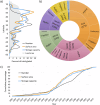The Global Dam Watch database of river barrier and reservoir information for large-scale applications
- PMID: 39379379
- PMCID: PMC11461629
- DOI: 10.1038/s41597-024-03752-9
The Global Dam Watch database of river barrier and reservoir information for large-scale applications
Abstract
There are millions of river barriers worldwide, ranging from wooden locks to concrete dams, many of which form associated impoundments to store water in small ponds or large reservoirs. Besides their benefits, there is growing recognition of important environmental and social trade-offs related to these artificial structures. However, global datasets describing their characteristics and geographical distribution are often biased towards particular regions or specific applications, such as hydropower dams affecting fish migration, and are thus not globally consistent. Here, we present a new river barrier and reservoir database developed by the Global Dam Watch (GDW) consortium that integrates, harmonizes, and augments existing global datasets to support large-scale analyses. Data curation involved extensive quality control processes to create a single, globally consistent data repository of instream barriers and reservoirs that are co-registered to a digital river network. Version 1.0 of the GDW database contains 41,145 barrier locations and 35,295 associated reservoir polygons representing a cumulative storage capacity of 7,420 km3 and an artificial terrestrial surface water area of 304,600 km2.
© 2024. The Author(s).
Conflict of interest statement
The authors declare no competing interests.
Figures






References
-
- World Commission on Dams (WCD). Dams and development: A new framework for decision-making: The report of the World Commission on Dams. Earthscan, 404 pp., https://riverresourcehub.org/resources/dams-and-development-a-new-framew... (2000).
-
- Richter, B. D. et al. Lost in development’s shadow: The downstream human consequences of dams. Water Alternatives3, 14–42 (2010).
-
- Reidy Liermann, C., Nilsson, C., Robertson, J. & Ng, R. Y. Implications of dam obstruction for global freshwater fish diversity. Bioscience62, 539–548, 10.1525/bio.2012.62.6.5 (2012).
-
- Winemiller, K. O. et al. Balancing hydropower and biodiversity in the Amazon, Congo, and Mekong. Science351, 128–129, 10.1126/science.aac7082 (2016). - PubMed
Grants and funding
LinkOut - more resources
Full Text Sources

